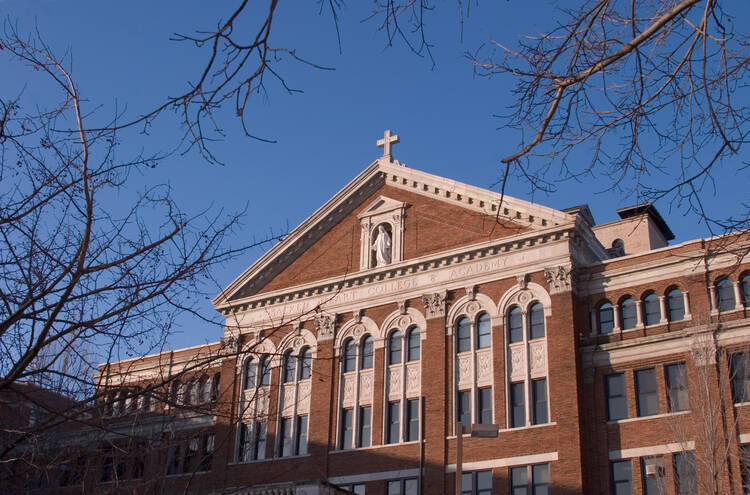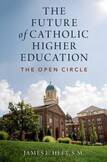Review: Do Catholic universities have a future?
The secularization of Protestant higher education in the United States was the result of incremental dalliances with secular culture that took at least a century to reveal their full weight and impact. The secularization of Catholic higher education in this country, by contrast, was the result of a cultural lightning strike that took mere decades, if not just a few short years, to reveal its effects.
Through the 1950s and even into the early 1960s, most Catholic colleges and universities in the United States largely lived unto themselves as wholly Catholic cultures. Their students, faculties and staffs often existed as what some critics referred to as “bunker Catholics.” The expectations for the lives they shared were largely as predictable as they were secure in expectations.
No sooner had the Second Vatican Council’s doors closed in 1965 than the clarity and security of those expectations began to fade. Many priests, sisters and brothers who once led (and provided low-cost labor to) Catholic colleges and universities chose to pursue other callings. Laypeople who took over their roles often did not have the same appreciation for, or understanding of, the charisms of the institutions they then began to lead. When Catholic colleges and universities left their bunkers, the need for an appreciation for the riches of the Catholic intellectual tradition was nothing short of great.
Heft's central concern is not only how “to preserve the continuity of the Catholic intellectual tradition, but also recognize how it might be adapted.”
How to cultivate such an appreciation is the focus of the Rev. James L. Heft’s The Future of Catholic Higher Education: The Open Circle. Heft, a former provost at the University of Dayton and founding director of the Institute for Advanced Catholic Studies at the University of Southern California, is an expert on Catholic higher education and contemporary Catholic life.
His central concern in The Future of Catholic Higher Education is not only how “to preserve the continuity of the Catholic intellectual tradition, but also recognize how it might be adapted.” Heft borrows from Nicholas of Cusa the image of a circle as a way to illustrate “how our knowledge of God in this life can never be complete.” The Catholic university, Heft argues, is a community that can be defined as an open circle because of its ability to engage with other traditions.
With intellectual dexterity, Heft turns to an array of resources from the humanities and social sciences to support his argument. (Other, comparable studies are often heavy on descriptive appraisals drawn from sociology or normative propositions drawn from theology.) Heft thus not only provides his readers with an astute understanding of present realities but also a clear vision for future possibilities.
In order to make that argument and assemble the needed resources, Heft divides his book into four parts over 15 chapters. Part I focuses on the lives and legacies of Jesus, Mary and St. John Henry Newman as points of theological inspiration for the Catholic university. For example, Christ’s presence in the Mass and the ongoing ministry of the Holy Spirit affords the Catholic university with a sacramental appreciation for God’s presence in all it explores. Such an appreciation sees and is in open dialogue with what other ways of seeing capture. However, it also values God’s ongoing presence in the world.
As Heft writes, “Catholic higher education is important not only for the Church and our country but also for the world.”
With that theological framework in place, Heft focuses in Part II on the relationship shared by the Catholic university and the church. Heft acknowledges that critics may view the Catholic Church as an entity that limits the reach of the Catholic university’s pursuit of truth. Drawing again on the image of the open circle, Heft sees such a relationship—when properly ordered—as necessary for a full appreciation of reality. Absent such a relationship, the university’s appreciation for God’s ongoing presence in the world is limited at best.
In Parts III and IV, Heft moves toward working through more practical details concerning how the relationship with the church is found in the identity and work of the faculty—and then the relationship the faculty shares with co-curricular educators or student life professionals. Faculty are often viewed as a secularizing force driven by their commitment to freedom wherever truth may lead. Heft views such debates as they work themselves out (for example, in relation to liberal education and research) as opportunities that need purposeful direction that reflects the riches of the Catholic intellectual tradition.
Despite the successful ways Heft argues for the integral strength of the Catholic university as an open circle, his insights concerning the role student life professionals or co-curricular educators play fall short of his insights concerning the role faculty or curricular educators play. Part III, focusing on faculty, includes five chapters; Part IV, focusing on student life professionals and co-curricular educators, has only two. Heft makes little mention of the roles of residential life, student leadership and activities, multicultural programs, calling and career offices, intramural athletics, and intercollegiate athletics in the “open circle.” While campus ministry programs are addressed at length, none of those other areas—areas also critical to student formation—are mentioned at a sufficient length.
Time will tell whether the open circle as Heft proposes will hold. He makes a successful argument for its value, showing how the Catholic university is uniquely poised to cultivate a full appreciation of reality. Prayerfully heeding his words will invariably lead to a growing appreciation for how, as Heft writes, “Catholic higher education is important not only for the Church and our country but also for the world.”











